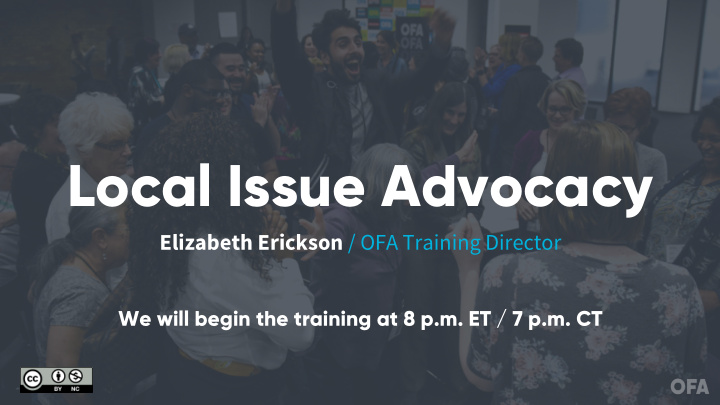



Local Issue Advocacy Elizabeth Erickson / OFA Training Director We will begin the training at 8 p.m. ET / 7 p.m. CT
“Never doubt that a small group of thoughtful, committed citizens can change the world.”
“Indeed, it is the only thing that ever has.” —MARGARET MEAD
Goal for Identify all the components of local 1 advocacy work this session Express that local change is possible 2 and necessary for this point in time Feel a sense of community with the 3 group
Tonight’s Welcome and Introductions agenda Local organizing examples Expectations & overview Applying advocacy – problems and issues Synthesis Closing & next steps
Guided worksheet BIT.LY HERE
When was the first time you remember observing your community change for the better?
WE ARE OFA Local Issue Advocacy Foundations
Tonight’s Welcome and Introductions agenda Local organizing examples Expectations & overview Applying advocacy – problems and issues Synthesis Closing & next steps
Local Level Examples South Montgomery Little Village Carolina Bus Boycott Coal Plants Buses
What makes you excited as you think about working at a local level? Be ready to share your name, city, and answer to the above question with the group.
Tonight’s Welcome and Introductions agenda Local organizing examples Expectations & overview Applying advocacy – problems and issues Synthesis Closing & next steps
Goals
Equip individuals with the skills to identify root problems in their 1 community, and propose a campaign plan addressing these root problems.
Equip individuals with the skills to identify root problems in their 1 community, and propose a campaign plan addressing these root problems. To identify all the components of successful coalitions, and apply these 2 elements of building a coalition in their community
Equip individuals with the skills to identify root problems in their 1 community, and propose a campaign plan addressing these root problems. To identify all the components of successful coalitions, and apply these 2 elements of building a coalition in their community To explain current legislation surrounding their issue, and take 3 appropriate action
Equip individuals with the skills to identify root problems in their 1 community, and propose a campaign plan addressing these root problems. To identify all the components of successful coalitions, and apply these 2 elements of building a coalition in their community To explain current legislation surrounding their issue, and take appropriate 3 action To analyze the barriers and challenges that we face as we implement 4 our campaign plans, and persevere strategically
Equip individuals with the skills to identify root problems in their 1 community, and propose a campaign plan addressing these root problems. To identify all the components of successful coalitions, and apply these 2 elements of building a coalition in their community To explain current legislation surrounding their issue, and take appropriate 3 action To analyze the barriers and challenges that we face as we implement our 4 campaign plans, and persevere strategically The develop a community of learners that support, push, challenge, and 5 celebrate each other
We believe in your leadership.
Our learning Week 1: Introductions; advocacy overview journey Workshop Week 2: Foundations of coalition building Week 3: Workshop Week 4: Identifying legislation Week 5:
Our learning Workshop Week 6: journey Writing your campaign plan Week 7: Workshop Week 8: Running into barriers Week 9: Closing synthesis and next steps Week 10:
STRATEGY METAPHOR Greek helmsman
Questions?
Tonight’s Welcome and Introductions agenda Local organizing examples Expectations & overview Applying advocacy – problems and issues Synthesis Closing & next steps
In the beginning, the organizer’s first job is to create the issue or problems.
What do we mean by advocacy? Cause Advocacy is an active promotion of a cause or principle Actions Advocacy involves actions that lead to a selected goal Community Effective advocacy uses the strengths of community members
Advocacy usually involves getting government, business, schools, or large institutions to correct an unfair or harmful situation affecting people in the community. Community Tool Box
Essential Understanding Recognizing Components the issue allies Advocacy usually involves getting government, business, schools, or large institutions to correct an unfair or harmful situation Developing Landscape of a plan for affecting people in the legislation advocacy community.
Essential Components Advocacy usually involves Understanding getting government, the issue business, schools, or large institutions to correct an unfair or harmful situation affecting people in the community.
Problems vs. Issues
Problems = Broad areas of concern Examples: unaffordable health care, pollution, unemployment
Issues = Solution or partial solution to a problem Example: enacting a local clean energy plan
Reflection Think about what brought you to this work. • How would you currently describe the problem that your community is facing? • How would you describe the issue you are working on? • Type your answers on this google doc , and be ready to share!
Breakouts
Indicators of • Result in the improvement of people’s lives good issues…. • Make people aware of their own power • Be winnable • Be widely felt • Be deeply felt • Be easy to understand • Have a clear decision maker • Have a clear time frame • Be consistent with your values and vision
Group share
Tonight’s Welcome and Introductions agenda Local organizing examples Expectations & overview Applying advocacy – problems and issues Synthesis Closing & next steps
Debrief What ways do you want to narrow your issue? What challenges do you foresee?
Next session
Thank you for joining today’s webinar. Please fill out the survey below and give us your feedback on today’s training. bit.ly/AdvocacyBeliefs
Recommend
More recommend